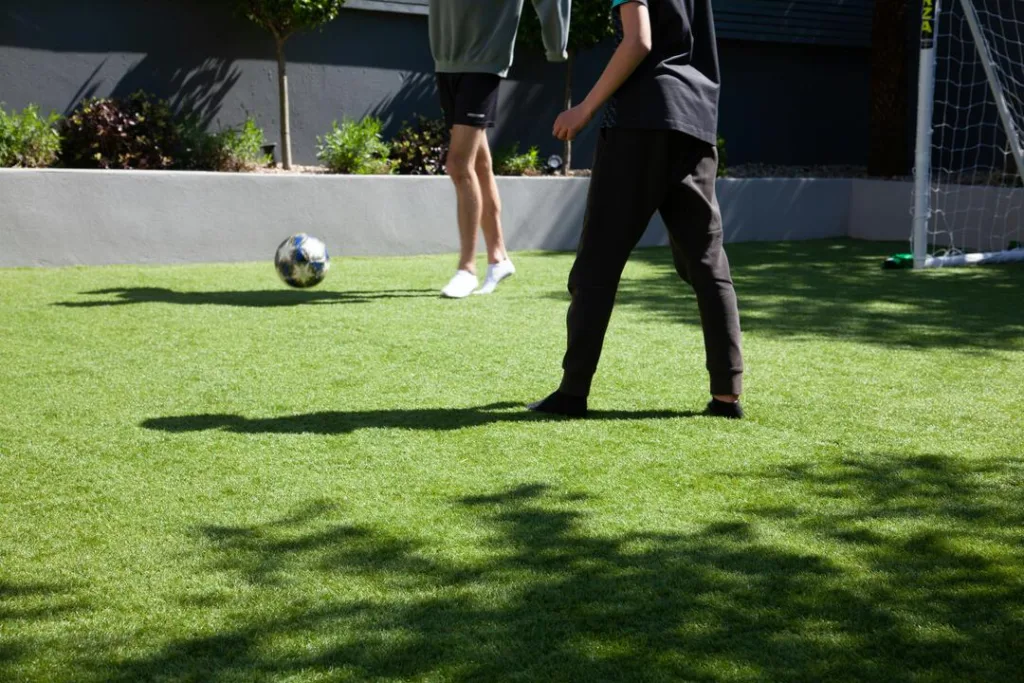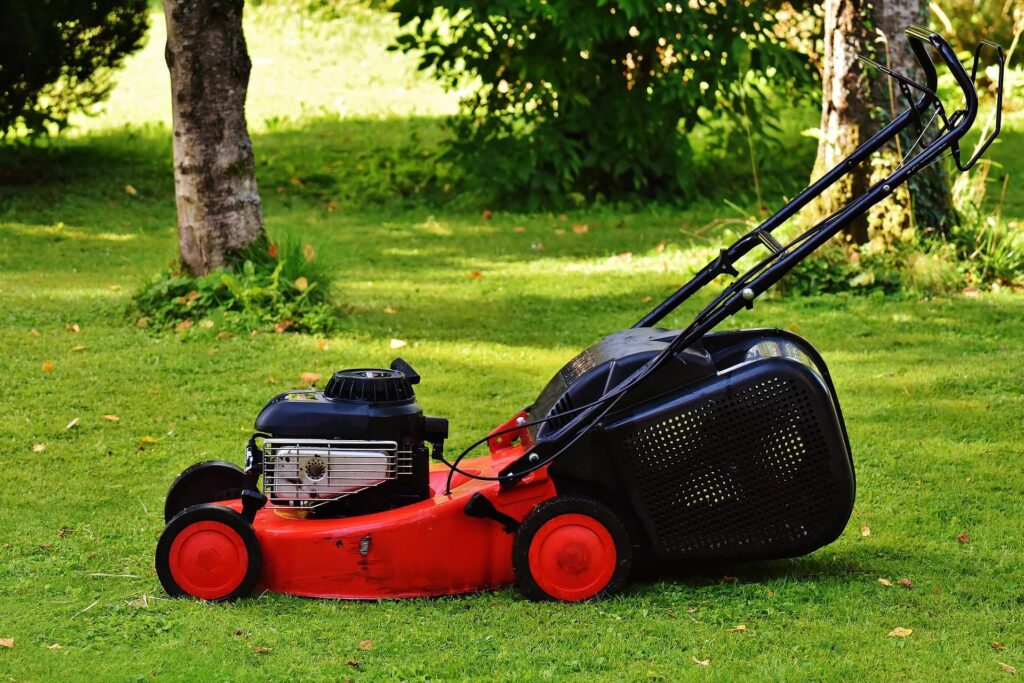Lawns are often the centerpiece of a yard, a lush green carpet that beautifies the home and provides a space for recreation. However, frequent foot traffic and heavy use can lead to lawn stress, soil compaction, and eventual damage.
Whether it’s children playing, hosting barbecues, or simply taking daily walks across the turf, your grass can suffer. But don’t worry—managing lawn traffic stress effectively can ensure your lawn remains healthy and vibrant all year round.
Introduction
Imagine this: a vibrant, green lawn that’s not just lovely to look at but also withstands the daily hustle and bustle of kids playing, friends and family gathering for weekend barbecues, or just regular walks with your furry friend. Sounds great, right?
But keeping your lawn lush and healthy amidst frequent foot traffic is a bit like throwing a party and expecting no cleanup afterward—it’s just not practical. Recognizing the signs of wear and understanding how to manage them effectively is crucial for maintaining a beautiful space.

Identifying Signs of Lawn Traffic Stress
Lawn traffic stress is a common issue facing many homeowners, characterized by:
- Constant walking paths
- Playful children
- Heavy gardening equipment
These activities can create visible signs of stress on your lawn, such as:
- Thinned patches of grass
- Compacted areas that appear pressed down
Addressing Lawn Stress
A healthy lawn not only enhances your home’s curb appeal but also creates a more enjoyable outdoor living space. Ready to learn how to keep your lawn looking its best? Keep reading!
Understanding Lawn Traffic Stress
Lawn traffic stress, essentially, is what happens when your lawn gets stepped on more than it can handle. Think about it like a popular nature trail vs. a quiet backwoods path. The popular trail shows signs of wear—packed dirt, exposed roots—because it sees a lot of feet. Same thing happens to your grass.
Primary culprits? Regular walking, kids’ games, or any fun shindig you throw in your backyard. All these press down on the grass and soil. Over time, this traffic beats your lawn down, makes the soil hard as a rock, and, well, sometimes the grass just gives up and stops growing where it’s stepped on the most.
The most obvious signs that your lawn is feeling the pressure include areas where the turf has thinned out or patches where the soil peaks through, almost bald. Then there’s soil compaction—when the soil gets so smooshed together that air, water, and nutrients can’t mosey around like they should.
This doesn’t just make it tough for roots to get what they need to thrive. It also makes your lawn feel kind of like walking on a cheap, hard mattress. Not comfy—neither for you nor your grass.
Best Practices for Managing Foot Traffic on Your Lawn
To protect your green space from the wear and tear of constant footfalls, consider these practical tactics:
First up, think about mapping out designated walkways. Whether it’s stepping stones, mulch paths, or paved sidewalks, guiding foot traffic can dramatically reduce the burden on your grass. It channels movements into specific areas, allowing the rest of your lawn to thrive unhindered.
Another key strategy? Mix it up. Encourage people to use different parts of the yard rather than trampling the same area repeatedly. This might mean rearranging your outdoor furniture now and then or setting up play areas in different spots throughout the season. It’s all about distributing the wear more evenly.
When it comes to planning events, timing is everything. If you’re hosting a big garden party or family reunion, give your lawn a break afterward to recuperate. Avoid scheduling back-to-back high-traffic events if possible. A little breathing room can do wonders for your lawn’s resilience.
By setting up these simple practices, your lawn won’t just survive; it’ll thrive, even under the feet of a dozen playful children or during your annual summer barbecue bash.
Selecting the Right Grass for High-Traffic Areas
Choosing the appropriate type of grass for high-traffic areas is crucial if you’re aiming to maintain a resilient and healthy lawn despite constant use. Not all grass types are equal when it comes to durability and recovery speed. Here, we’ll dive into some of the best grass types suited for these demanding conditions and offer advice on whether to go for seed or sod, based on your local climate and soil type.
Best Grass Types for Durability and Recovery
Tall Fescue: Known for its deep roots and tolerance to foot traffic, tall fescue is a robust option. It’s suitable for cooler climates and maintains its vigor despite frequent use.
Bermuda Grass: Highly favored in warmer regions, Bermuda grass can withstand heat and recuperates quickly from damage. Its aggressive growth pattern helps it repair itself after being trampled.
Kentucky Bluegrass: Kentucky Bluegrass is not only pleasing to the eye but also has a remarkable ability to self-repair thanks to its rhizomatic growth. It thrives in cooler climates and is a good choice for active, family-used lawns.
Zoysia Grass: Ideal for warm climates, Zoysia has a dense growth habit which makes it resistant to wear and tear. It also has a smooth texture, making it comfortable for bare feet.
Seed or Sod? Making the Right Choice
When it comes to establishing or repairing a high-traffic lawn, deciding between seed and sod can depend on a few key factors:
Speed of Establishment: Sod offers an instant lawn and can be used almost immediately after installation, making it ideal for urgent needs. Seeding, however, is more cost-effective but requires time to establish.
Climate Considerations: In colder climates, sod might be preferable as it can take hold before the winter freezes. For warmer areas, seeding might be sufficient as it can occur almost year-round.
Soil Conditions: If your soil is prone to erosion, sod can help stabilize the area quickly. Seed, on the other hand, might struggle in eroded or very compact soils without prior amendment.
By selecting the right type of grass and deciding wisely between seeding and sodding based on your specific conditions, you can not only enhance the durability of your lawn but also ensure it remains lush and vibrant despite high foot traffic. Whether you’re dealing with kids playing fetch with the dog or hosting weekly barbecue nights, your grass will be ready to withstand the hustle and bustle.

Everyday Tips to Maintain Health in High-Traffic Lawns
Maintaining a lush and resilient lawn, despite constant foot traffic, requires consistent tender lawn care (TLC). Here are some effective strategies to help keep your high-traffic grass areas healthy and vibrant.
Mowing Smartly
- Optimal Height: Ensure you’re cutting your grass at the ideal height for its type. Mowing too short can stress the grass, enhancing wear and tear vulnerability, while too long can foster pests and diseases. A height of about 2.5 to 3 inches works well for most types.
- Sharp Blades: Use sharp mower blades to achieve clean cuts, which help prevent grass damage and disease.
Watering Wisdom
- Best Times: Water early in the morning to minimize evaporation and allow deeper soil penetration.
- Right Amount: Avoid overwatering to prevent weakening the grass roots. Aim for about an inch of water per week, considering rainfall.
Fertilizing Regularly
- Balanced Nutrition: Apply a balanced fertilizer that provides essential nutrients like nitrogen, phosphorus, and potassium.
- Slow-Release Fertilizers: Opt for slow-release fertilizers to nourish your lawn gradually.
- Timing: Fertilize strategically before expected high-traffic to enhance lawn resilience.
Managing Traffic Patterns
- Alter Paths: Encourage varied footpaths to prevent soil compaction in the same areas, which can block air and water from reaching the roots.
- Use Pathways: If altering paths is not feasible, install stepping stones or design a pathway to protect heavily trafficked sections.
Prompt Attention to Lawn Issues
- Immediate Action: Tackle problems such as bare patches, weeds, or pest signs right away to avoid escalation and further damage.
Integrating these practices into your lawn care routine will not only preserve the health of your grass but also improve its ability to withstand and recover from the stress of high traffic. Regular attention and care are key to a thriving garden.
Techniques for Rehabilitating Damaged Lawn Areas
When your lawn looks more like a well-trodden path than a lush garden, it’s time to step up the restoration game. Here’s a straightforward guide to bringing those battered patches back to life.
Step 1: Assess and Amend Compacted Soil
First things first: deal with the compaction. Regular use tends to press down the soil, limiting how much air, water, and nutrients reach the roots of your grass. To fix this, grab a garden fork or a core aerator and start loosening up. Aerate your lawn by creating holes every few inches across the affected areas. This gives the soil room to breathe and improves the overall health of your grass.
Step 2: Reseed or Patch Worn Areas
Once your soil can breathe again, it’s time to bring back the green. If the damage isn’t too widespread, spot treatment with seeds or even sod patches can do the trick. Choose a grass type matching your existing lawn (or consider a more resilient variety if wear is a recurring issue). Sow the seeds or lay the sod, then keep the area moist until the new grass takes root and starts to fill in. Remember, patience is key.
Step 3: Optimize Watering and Fertilization
Post-repair care is crucial. Overwatering can swamp new seeds or sod, while under-watering might leave them high and dry. Aim for the sweet spot: enough water to keep the soil moist but not soggy. As for fertilizing, give your lawn a balanced meal; a slow-release nitrogen fertilizer encourages healthy growth without overwhelming young grass.
With these steps, you can transform a sad-looking section of your yard into a vigorous, resilient turf ready for whatever comes its way. Keep up with regular maintenance, and your lawn will thank you with lush, green blades that stand up to foot traffic—and look good doing it.

Advanced Methods: Aeration and Dethatching
Aeration is a lifesaver for any lawn suffering the squeeze of soil compaction. Here’s the deal: just like you, your lawn’s soil needs to breathe. When we walk, play, or even just hang out on the grass, it presses down the soil, impacting its ability to absorb air and water.
Aerating, essentially poking holes throughout your lawn, loosens up the soil, making it easier for oxygen, water, and nutrients to penetrate and reach the roots where they’re most needed. For most lawns, aerating once a year does the trick, but if your lawn hosts more soccer games than a local park, considering aerating twice might just be your move.
Now, let’s talk dethatching. Thatch is like that one guest who overstays their welcome at your lawn party. It’s a layer of dead grass blades, roots, and debris that accumulates between the soil surface and the living grass. A little bit, say half an inch, can actually be beneficial, acting as a mulch to regulate temperature and moisture.
But when it builds up too much, it blocks water, nutrients, and air from seeping through and can even harbor pests and diseases. Dethatching removes this clingy layer, encouraging your lawn to breathe freely and soak up all the good stuff. The best practice? Tackle this chore in early fall or spring when your lawn is in its peak growing period, ensuring it recovers quickly and heartily.
Both aerating and dethatching are integral to maintaining a lawn that not only looks good but is also structurally sound enough to handle whatever your feet throw its way. Whether you’re a DIY enthusiast or prefer to hand it over to the pros, these methods can boost your lawn’s health, making it more resilient and ready to face high-traffic challenges. The bottom line? Giving your lawn a little room to breathe goes a long way.
Innovative Solutions to Manage Lawn Traffic
When it comes to preserving the health and appearance of your lawn amidst constant foot traffic, sometimes traditional tactics just don’t cut it. Let’s dive into some innovative solutions that help manage lawn traffic and reduce the reliance on grassy areas, thereby minimizing damage.
Ground Protection Mats
One of the more straightforward innovations in lawn care involves the use of ground protection mats. These mats are designed to distribute the weight of foot traffic or heavy equipment evenly, preventing the grass underneath from being crushed. Not only are they effective at protecting the lawn during events or construction, but they’re also easy to install and remove. These mats come in various materials and sizes, ensuring there is a solution that fits every lawn’s specific needs.
Alternative Landscaping Elements
Reducing grass dependency is another key strategy. By integrating alternative landscaping elements, you can create a beautiful and practical outdoor space that requires less maintenance than traditional grassy areas. Some popular options include:
Paving Stones and Walkways: Designating specific areas for walking can significantly reduce wear and tear on your lawn. Paving stones or stepping stones provide a sturdy and attractive pathway that directs foot traffic away from vulnerable grass areas.
Mulch and Ground Covers: Using mulch in high-traffic areas or around playground equipment can reduce soil compaction and prevent wear. Ground covers like creeping thyme or sedum are hardy, look attractive, and can withstand some foot traffic, offering a greener alternative to areas where grass might struggle.
Artificial Turf: If durability is your primary concern, consider sections of artificial turf. Modern synthetic grasses look surprisingly real and require minimal upkeep, making them an excellent option for heavily trafficked areas.
Implementing these innovative solutions doesn’t just save your lawn; it can shift the very concept of what a lawn has to mean aesthetically and functionally. With these tools, your green space stays robust, no matter the traffic it faces. Remember, every step you take in planning can help preserve the beauty and health of your lawn for years to come.
Encouraging Healthy Growth and Quick Recovery
Keeping your lawn resilient against heavy foot traffic isn’t just about immediate protection—it’s also about fostering healthier, quicker recovery after it’s been stepped on repeatedly. Let’s dive into a couple of solutions that can help your grass bounce back faster and stay green, no matter how many feet tread on it.
Harness the Power of Recovery Products
There is a whole arsenal of products designed specifically to aid in the proper recovery of your grass. These can range from high-nutrient fertilizers that provide the necessary boost to outgrow and outlive damage, to growth stimulants that encourage quicker blade and root recovery. Look for products rich in nitrogen, which is essential for foliage growth, but ensure the balance is right to avoid causing other issues like excessive thatch.
Importance of Recovery Periods
Equally important as the products you use are the rest periods you give your lawn. Grass, like any living thing, needs some downtime to repair itself. After periods of heavy use—think large family gatherings or an active barbecue—it’s wise to give your turf a break.
This might mean roping off worn areas for a time or scheduling a few low-traffic days, allowing the grass to recover without the constant stress of footfalls.
With the right recovery techniques and a little scheduling savvy, your lawn can stay lush and vibrant, ready to handle everything from rough plays to garden parties.
Conclusion
In wrapping up, the solutions and strategies we’ve discussed are integral for anyone eager to maintain a scenic, vigorous lawn amidst frequent foot traffic. From choosing the toughest types of grass for high-traffic areas to understanding the crucial role of aeration and designated pathways, each recommendation serves to fortify your lawn against the wear and tear of daily life.
Taking a proactive approach to managing lawn traffic stress—not only preserves the lush appearance of your turf but also contributes to its long-term health and durability. Whether you’re dealing with kids’ play areas, frequent backyard gatherings, or just the usual footfall, applying these insights will help ensure your grass stays resilient.
So, keep these tips in mind, stay consistent with your lawn care regimen, and don’t hesitate to try out new methods to alleviate stress on your turf. Here’s to enjoying a vibrant, enduring lawn that serves as a foundation for many cherished outdoor moments!


